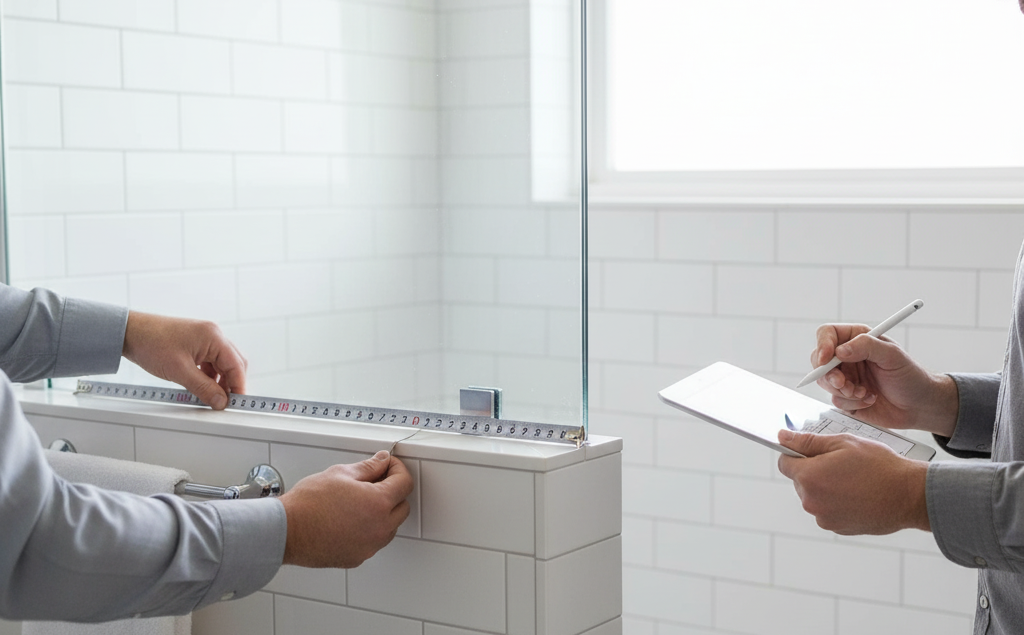How to Measure for a Sliding Shower Door
Installing a sliding shower door is a practical and elegant way to upgrade any bathroom. Unlike swinging doors, sliding doors save space, provide a sleek appearance, and enhance the overall functionality of the room. However, one of the most crucial steps before installation is taking accurate measurements. Incorrect measurements can lead to a door that doesn’t fit properly, causes leaks, or operates poorly. Whether you are replacing an old door or installing one in a new bathroom, understanding how to measure for a sliding shower door ensures a perfect fit and a long-lasting solution.
This guide will walk homeowners through the process step by step, with tips on avoiding common mistakes, understanding different door styles, and selecting the best option for your bathroom space.
Why Measuring Properly for a Sliding Shower Door Matters
Many homeowners underestimate the importance of precise measurements when it comes to sliding shower doors. Even a small error in width or height can result in a door that either doesn’t slide smoothly or fails to seal correctly, allowing water to escape the shower area. Proper measurements also ensure the aesthetic alignment of the door with the rest of the bathroom, helping maintain a clean and polished look.
Additionally, bathroom walls and shower bases are rarely perfectly square. Walls can bow slightly, tiles may not be perfectly level, and shower pans can settle unevenly over time. By carefully measuring all critical dimensions, you can account for these inconsistencies and choose a door that fits seamlessly, preventing frustration during installation.
For homeowners seeking quality products, exploring sliding shower doors in Berwyn offers access to designs that combine functionality, durability, and smooth operation, suitable for a wide range of bathroom layouts.
Gather the Necessary Tools
Before beginning any measurements, it’s essential to have the right tools on hand. A reliable measuring tape, a level, and a notepad to record dimensions are critical. A pencil or marker is useful for marking measurements without causing permanent damage. In some cases, having a helper can make measuring large openings easier and more accurate. Accuracy is key here, as even a fraction of an inch can make a significant difference in the final installation.
Preparing the right tools beforehand saves time and ensures that every measurement is precise, which is especially important when ordering a custom sliding shower door.
Measure the Width of the Shower Opening
To begin, measure the width of the shower opening at three different points: the top, the middle, and the bottom. Record each measurement carefully. Since most walls are not perfectly square, the narrowest measurement should be used as the reference width. This ensures that the door will fit comfortably without rubbing against the walls or track.
It is also recommended to leave a small clearance, typically about a quarter of an inch, to allow the sliding door to move freely. This minor adjustment prevents binding and ensures smooth operation over time. Accurate width measurements are essential not only for fit but also for the door’s long-term performance and ease of use.
Measure the Height of the Shower Opening
After measuring the width, the next step is to determine the height of the shower opening. Measure from the top edge of the shower base or bathtub to the highest point where the door will be installed. Take measurements at both ends and in the center, as floors and walls may not be perfectly level.
Use the shortest measurement as the reference for door height. This precaution ensures that the door will fit properly without scraping the top frame or interfering with overhead fixtures. It is important to measure carefully, as even minor differences in height can affect the installation, potentially causing gaps, water leakage, or difficulty in sliding the door.
When selecting a door style for your bathroom, consider Why Sliding Shower Doors Are the Top Choice for Small Bathrooms, as they save space and provide a modern, clean look without the obstruction of swinging doors.
Check for Obstructions and Clearances
Before finalizing measurements, check the surrounding area for any potential obstructions. Towel bars, faucets, shelves, or other bathroom fixtures can interfere with the door’s operation. Ensure there is adequate clearance for the sliding tracks and that the door can open and close without obstruction.
Additionally, check the level and plumb of the walls and shower base. Uneven surfaces can create alignment issues, making it necessary to adjust measurements or consider minor modifications during installation. Taking these factors into account early prevents issues that might require costly adjustments later.
Record and Double-Check All Measurements
Once measurements for width, height, and clearance have been taken, record them carefully on paper or a digital device. Double-check each measurement to ensure accuracy. A small oversight can result in a door that doesn’t fit correctly, leading to frustration and additional expenses.
Creating a simple sketch of the shower opening, including all relevant dimensions, can also help installers or sales representatives understand the space better. Annotating the diagram with notes about uneven walls or potential obstructions adds an extra layer of accuracy, especially for custom sliding doors.
Consider the Shower Door Style
After obtaining precise measurements, homeowners should consider the style of sliding shower door that best fits their bathroom. Options include framed or semi-frameless doors, fully frameless doors, and various glass finishes such as clear, frosted, or textured. Each style has different clearance requirements, track designs, and installation methods.
Frameless doors often provide a sleek, modern appearance but may require more precise measurements and professional installation. Framed or semi-frameless doors are more forgiving in terms of measurement and often include built-in tracks and water seals to minimize leaks. Choosing the right style ensures that the door not only fits perfectly but also complements the overall design of the bathroom.
Preparing the Shower Area for Installation
Before installing the door, prepare the shower area thoroughly. Remove any old doors, curtain rods, or obstructions, and clean the surfaces where the new tracks or frames will be mounted. Check for damage to tiles, walls, or the shower base and make any necessary repairs to ensure a level and secure installation surface.
It is also important to verify that the shower base is level. Uneven bases can cause misalignment, leading to gaps, binding, or leaks in the sliding door. Taking the time to prepare the area correctly ensures a smoother installation process and reduces the likelihood of post-installation issues.
Ordering and Custom Glass Considerations
With accurate measurements in hand, homeowners can now order the sliding shower door that fits their space. For custom or non-standard shower openings, consulting a professional glass supplier is often necessary. Custom glass solutions allow for precise adjustments in height, width, and track placement, accommodating unique bathroom layouts and non-square walls.
Professional installers can also advise on glass thickness, hardware finishes, and additional features such as soft-close rollers, water seals, or tempered safety glass. Selecting a high-quality custom sliding door ensures long-term durability, smooth operation, and a polished finish in your bathroom.
Common Measurement Mistakes to Avoid
Several common mistakes can compromise sliding shower door installation. One of the most frequent errors is measuring only the center of the opening and neglecting the top and bottom widths, which can lead to a door that binds at either end. Another mistake is failing to account for wall irregularities or uneven floors. Overlooking small details, such as towel bars or shelving, can also interfere with door operation.
By carefully measuring all critical dimensions and taking time to note potential obstructions, homeowners can avoid these pitfalls. A little extra attention during the measurement process saves time, money, and frustration during installation.
Professional Installation vs. DIY
While some homeowners may attempt to install a sliding shower door themselves, professional installation is recommended for custom or heavy glass doors. Professionals ensure accurate alignment, proper sealing, and smooth operation, reducing the risk of leaks or damage.
Even with a DIY approach, having precise measurements and a clear understanding of the steps involved is essential. If you choose to hire a professional, providing detailed measurements and a clear diagram of the shower opening will streamline the process and ensure a better result.
Maintenance and Long-Term Considerations
Once your sliding shower door is installed, proper maintenance is key to ensuring long-term functionality. Regular cleaning of glass surfaces and tracks, lubricating rollers if necessary, and inspecting seals for wear will help prevent leaks and maintain smooth operation.
Periodic checks for alignment and tightness of hardware prevent long-term problems. Homeowners who invest time in routine maintenance can enjoy a sliding shower door that operates flawlessly for many years, preserving both functionality and appearance.
Frequently Asked Questions (FAQs)
How accurate do my measurements need to be?
Accuracy within 1/8 inch is recommended. Even small discrepancies can affect door alignment and sealing.
Can I adjust a sliding door if my measurements were slightly off?
Minor adjustments are possible using the track system, but major differences may require reordering the door.
Are sliding doors better for small bathrooms than swinging doors?
Yes, sliding doors maximize usable space, prevent obstruction, and provide a sleek, modern look.
What glass thickness is ideal for sliding shower doors?
Typically, 3/8 inch or 1/2 inch tempered glass is standard, offering durability and safety.
Can I use a sliding door with a non-square shower opening?
Custom glass solutions can accommodate irregular openings, ensuring a perfect fit even with non-standard dimensions.
Conclusion
Measuring for a sliding shower door requires attention to detail, careful planning, and an understanding of bathroom layout. From taking precise width and height measurements to accounting for obstructions and selecting the right door style, each step contributes to a successful installation. Following these guidelines ensures smooth operation, a perfect fit, and a beautiful finish in any bathroom.
For homeowners seeking professional guidance and high-quality products, Berwyn Glass provides custom glass solutions in Berwyn, offering expertly crafted sliding shower doors tailored to your measurements, style, and functional needs.

